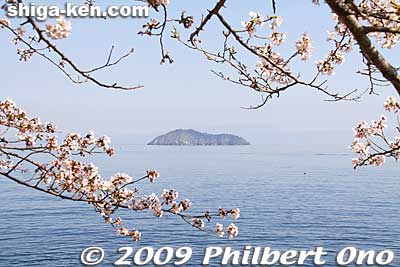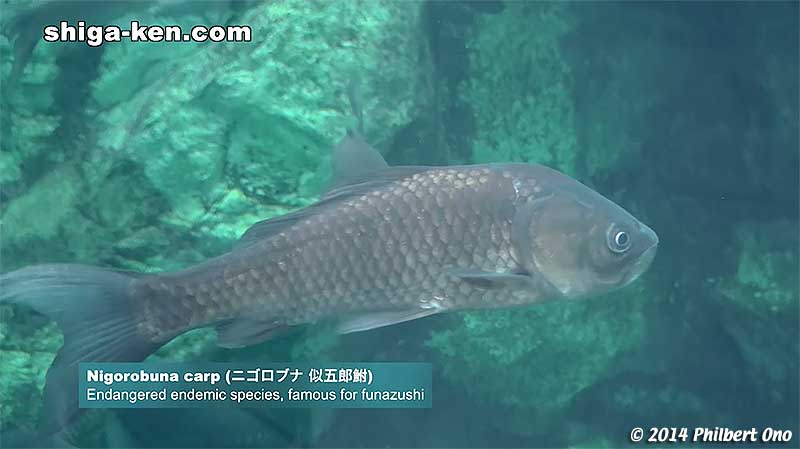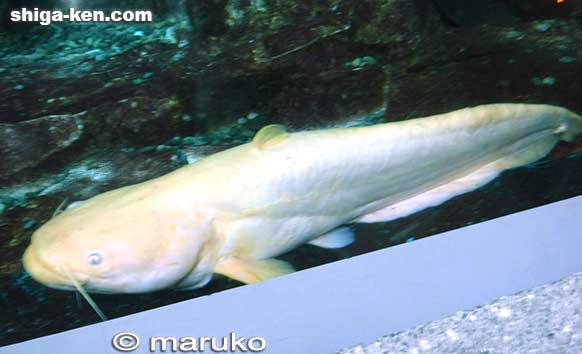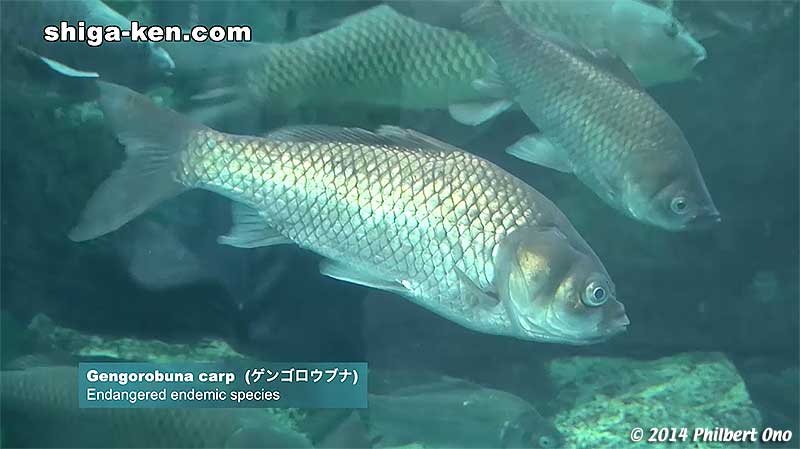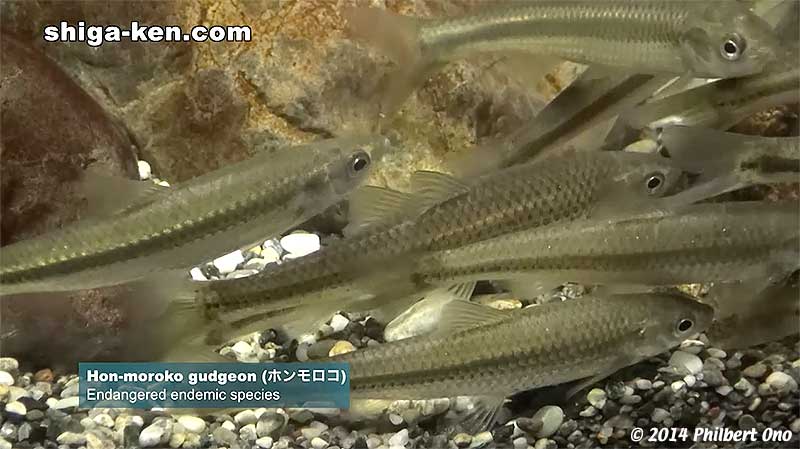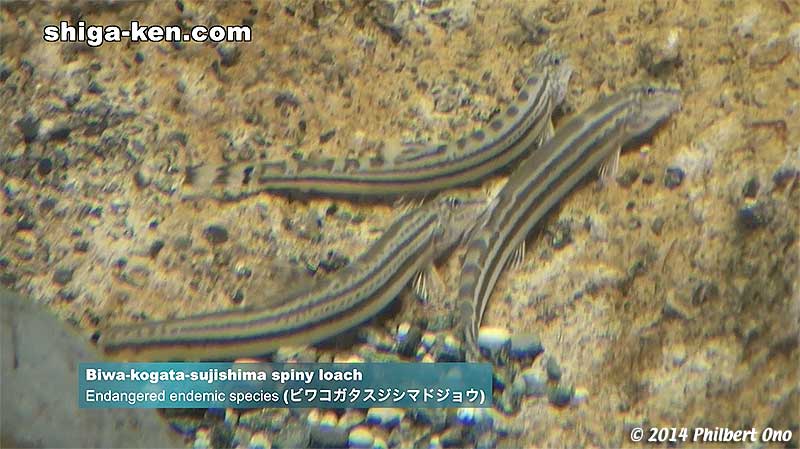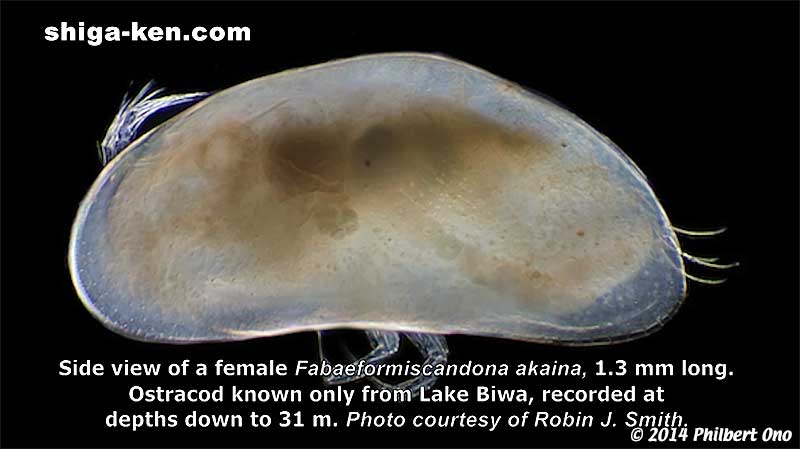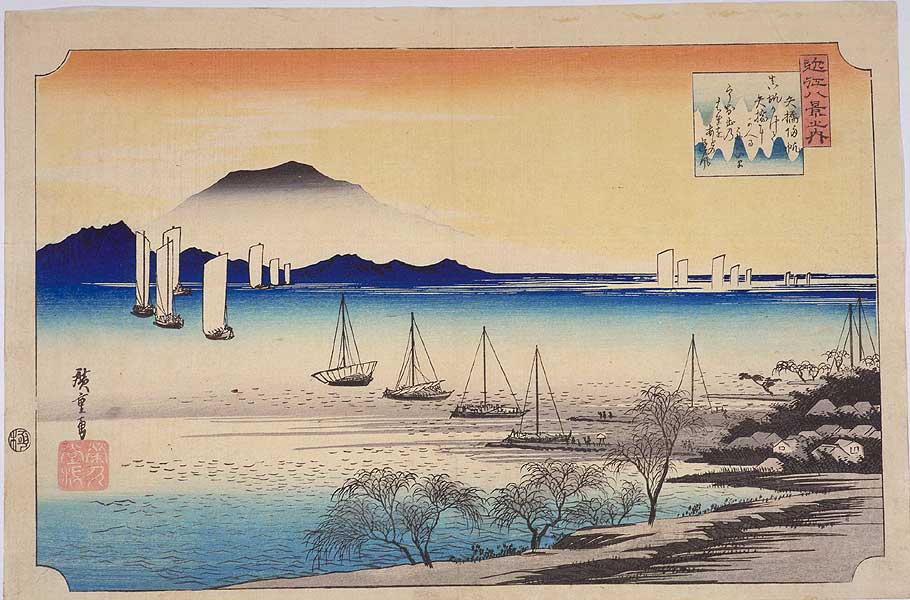Lake Biwa
by Philbert Ono, Updated: Sep. 21, 2017
| Chikubushima as seen from Kaizu-Osaki in northern Lake Biwa. |
| Lake Biwa satellite view |
Lake Biwa (Biwako 琵琶湖) is Japan's largest lake and one of the world's oldest lakes dating back 4 million years. Looking like a belly button near the center of Honshu island, it is easy to spot on a map of Japan in Shiga Prefecture.
The lake's long history and diverse habitats gave rise to over 70 endemic fish (17) and mollusk (30) species and subspecies found nowhere else. The Lake Biwa Giant Catfish, nigorobuna carp (famous for funazushi fermented fish), and Biwa salmon are among the best-known endemic species. The diverse habitats include rocky and sandy areas, cold waters, pelagic zones, reed beds, aquatic plants, rivers, and attached lakes. Smaller and even microscopic species like ostracods (seed shrimp) and ciliates endemic to Lake Biwa have also been recently discovered. Local researchers believe that there are more endemic microscopic species yet to be surveyed. (The Lake Biwa Museum video below shows the endemic species.)
In winter, hundreds of migratory birds like tundra swans from Siberia and bean geese from Kamchatka Peninsula migrate to Lake Biwa. Bird-watching in northern Lake Biwa is popular.
Invasive species like the black bass, blue gill, and invasive waterweeds have seriously affected the lake's ecology and population of endemic species. Modern development and land reclamation have also drastically reduced reed beds favored by young fish and birds. Countermeasures are being executed to increase reed beds, eliminate invasive species, and breed endemic species.
Surrounded by mountains, Lake Biwa is like a giant bowl collecting water from numerous inflowing rivers. It is an essential water supply for 14 million people in the Kyoto and Osaka area. This is why the restart of nuclear power plants in neighboring Fukui Prefecture is causing a major controversy and concern in Shiga Prefecture.
The greatest fear is a Fukushima-like accident in Fukui which would almost certainly contaminate the lake and affect the wildlife and drinking water for millions of people. Debate still continues over whether the power plants sit on an active and lethal earthquake fault. Expert scientists are saying that the fault is hazardous for the power plants, while the power company claims that the fault is not active.
Lake Biwa has also been a cultural inspiration over the centuries. The 8th-century Man'yoshu collection of Japanese poetry includes poems about Lake Biwa. The epic novel Tale of Genji written at Ishiyama-dera temple in Otsu in the 11th century by Lady Murasaki calls the lake "Nionoumi" (Lake of Little Grebes). (Little Grebe is Shiga's official bird.)
Also famous are the Eight Views of Omi (Omi Hakkei) woodblock prints by Hiroshige in the 19th century. (Omi is the former name of Shiga Prefecture when it was a feudal province.) In 1917, college student Oguchi Taro and his boatmates composed the song Biwako Shuko no Uta (Lake Biwa Rowing Song) during a rowing trip around the lake. The song later became a national hit and Shiga's most famous song.
Lake Biwa is part of the Biwako Quasi-National Park boasting a number of scenic points and areas: Sacred Chikubushima island, Mt. Hiei Driveway, Ukimido Floating Temple, Hikone Castle, Mt. Shizugatake, Kaizu-Osaki cherry blossoms, Shirahige Shrine (torii on the lake), Lake Yogo, and white-sand beaches like Omi-Maiko.
Other Lake Biwa facts:
- Water supply for 14 million people including Kyoto and Osaka.
- One-sixth of Shiga Prefecture's area.
- 235 km (146 mi.) of shoreline.
- Water surface area (669.23 sq. km) is larger than Tokyo's 23 wards (626.7 sq. km).
- 118 inflowing rivers.
- Only one outflowing river: Seta River in Otsu.
- Average depth 41 m, max. depth 104 m. North Basin is much deeper than the South Basin.
- Takes 2-3 days to bicycle around the lake.
- Biwako Ohashi Bridge (built in 1974) connects the east and west shores and serves as the border between the South Basin and the larger North Basin.
- Chikubushima is the lake's most famous island with a centuries-old sacred shrine/temple dedicated to the Goddess Benzaiten. Click here to read the folktale of how Chikubushima was created.
- Okishima, in Omi-Hachiman, is the largest island with a few hundred residents.
- Ramsar Site and wetland of international importance.
- Biwa means "lute."
Lake Biwa's Endemic Species
Photos of some of Lake Biwa's endemic species found nowhere else on Earth. Besides fish and mollusks, the lake also has microscopic endemic species like ostracods and protozoa. The lake's endemic species can be seen at Lake Biwa Museum's freshwater aquarium. Researchers are still discovering and describing new species (especially microscopic ones) in the lake.
See more photos of Lake Biwa's endemic species here.
History of Lake Biwa
| Returning Boats at Yabase by Hiroshige |
Seventeen million years ago, southeastern Shiga was under a warm ocean while Japan was in the process of separating from the Asian mainland. Fossils of dolphins and a baleen whale bone have been found in Tsuchiyama, Koka.
Lake Biwa's forerunner Lake Oyamada emerged about 4 million years ago southeast of Shiga in Iga, Mie Prefecture. Over millions of years, at least two lakes formed and disappeared before Lake Katata in western Otsu formed. This lake got larger and deeper as geological protuberances 400,000 years ago pushed it to where Lake Biwa is today.
Large Mie elephants roamed a subtropical lake land 3 to 4 million years ago. Two million years ago, the Mie elephant had become extinct and the smaller Akebono elephant lived in Shiga until it became extinct 1 million years ago.
Humans appeared around Lake Biwa about 9,000 years ago, mainly along the South Basin. They ate nuts, lake fish and shellfish, and wild animals. The Awazu Shell Mound of food waste from 4,500 years ago was excavated in 1990-91 near Seta River. The shells were mostly endemic Seta shijimi clams. Other refuse mixed in the shell mound revealed interesting things about life of the early settlers.
The lake's first primitive boat, called maruki-bune (丸木船), was a dugout canoe made from a single log. Maruki-bune have been found mainly in the Hikone-Maibara area in northern Lake Biwa. They were dated from 3,000 years ago (Jomon Period) and 1,800 years ago (Yayoi Period). Experts surmise that maruki-bune were used to paddle to Chikubushima and even to the other side of the lake.
A more modern boat, called maruko-bune (丸子船), was a wooden boat mainly for shipping cargo across Lake Biwa. Maruko-bune were a vital transportation and commerce link between northern Japan and Kyoto-Osaka. Maruko-bune transported rice, fish, kelp, and many other goods from northern Japan bound for Kyoto-Osaka. From Kyoto, came cotton, confections, soy sauce, sake, kimono, textiles, tobacco, and more. Merchandise coming and going via the Sea of Japan also crossed the lake.
The maruko-bune's heyday was during the 17th and 18th-centuries when over 1,000 maruko-bune traversed the lake. The busiest ports were Shiotsu in the north and Otsu in the south next to Kyoto. After railroads started to be built in the late 19th century, maruko-bune dwindled until there were no more on Lake Biwa. You can only see them displayed in museums and outdoor exhibits. Maruko-bune's trademark is a half-round cedar or cypress log on both sides.
Fishing has been the lake's major activity since the earliest settlers. Unfortunately, invasive fish devouring the fry of endemic species and thousands of cormorant birds gorging on commercial fish have seriously affected the local fishing industry.
Conservation efforts have been succeeding in increasing the fish stock of endemic fish like nigorobuna carp. In late spring, 5mm-long nigorobuna fry are released into rice paddies. It is where they remain safe from invasive predators and have much food in warm water. When the rice paddy is temporarily drained a month later, the baby fish, now about 2 cm to 3 cm long, exit the paddy in the drained water. They travel along the drainage ditch to Lake Biwa.
Another symbol of Lake Biwa is the fence-like eri fish traps. Eri have been in use for over 1,500 years. Traditional eri is an arrow-shaped bamboo fence in the water pointing away from shore. When fish encounters the center fence, it instinctively swims toward deeper water. The center fence thus leads the fish to the trap holes at the ends. Eri today have more sophisticated shapes and use modern materials instead of bamboo.
In 1890, after four years of monumental construction, the Lake Biwa Canal (Biwako Sosui) was completed to feed water from Lake Biwa to Kyoto. Kyoto was thereby revitalized with electric power and a stable water supply. A second, almost parallel canal was built in 1912 for drinking water. Kyoto has thrived ever since thanks to Lake Biwa. Shiga people have a joke for Kyoto people that says, "Be nice to us or else we'll turn off your faucet."
From World War II to 1969, the government reclaimed attached lakes and other shallow waters around Lake Biwa to create more land to grow rice amid a rice shortage. Attached lakes (naiko 内湖) are small bodies of water around Lake Biwa that got separated from the larger lake due to silt accumulated from rivers or other natural occurrences. They are similar to a lagoon, but remain connected to Lake Biwa usually through a small waterway. Since reed-filled attached lakes were the spawning grounds for fish and wildlife, the reclamation seriously affected the lake's ecology and wildlife. In 1940, there were over 40 attached lakes around Lake Biwa with a total surface area of 29 sq. km. Today, there are only 23 attached lakes with a total surface area of 4.25 sq. km. Since attached lakes are shallow, usually no more than 2 or 3 meters, they were easy to drain and reclaim.
In 2001, Hayasaki Naiko, a small attached lake reclaimed in Nagahama as a rice paddy, was partially reflooded as a biotope experiment to revert it back to a lake. The experiment proved to be successful as wildlife started to return to the flooded area with reed beds. However, due to financial reasons, the prefecture has been unable to buy back all the reclaimed land from the farmers to complete the attached lake's full reversion.
In 1963-64, the Japan Fisheries Agency gave 1,400 bluegill fish for cultivation in Lake Biwa. The fish was brought back by then Crown Prince Akihito given to him as a gift from Chicago, Illinois in 1960. Although the fish was meant to be cultivated for human consumption, by the mid-1970s, bluegill had spread all over the lake. In the 1990s, bluegill became a major problem for endemic fish.
At the 27th National Convention to Make Bountiful Oceans (第27回全国豊かな海づくり大会) in 2007 in Otsu, Emperor Akihito gave a speech and said, "It hurts my heart that the bluegill fish I brought to Japan from America for human consumption is now damaging the ecosystem of Lake Biwa." Well, it really wasn't his fault.
Another major problem was severe red tide in the late 1970s and early '80s. This prompted a grassroots movement to promote the use of laundry soap instead of synthetic detergent containing substances triggering red tide. They helped to prevent household waste water from polluting the lake and causing adverse effects like red tide.
Since then, Shiga has become very environment- and ecology-minded. In 1992, A new ordinance was passed to preserve Lake Biwa's reed beds which had shrunk from 260 hectares in 1953 to 130 hectares in 1991. Reeds serve to cleanse the water and provide a safe haven for young fish and birds. In 1993, Lake Biwa was registered in the Ramsar List of Wetlands of International Importance.
The Lake Biwa Museum opened in 1996 and it includes the Fish Conservation and Breeding Center where they breed endangered freshwater fish species and research breeding methods. Local 5th graders also learn about the lake from overnight cruises on the Uminoko "Floating School" cruise ship operated by the prefecture since 1983.
In 1999, the prefecture started its half-century Mother Lake 21 project to preserve and protect Lake Biwa. From 2002, the "No-release" ordinance took effect to prohibit people from throwing back into Lake Biwa any invasive species they catch. Fish disposal boxes along the shore have been provided.
Although noticeable improvements are being made, it is still taking decades to undo the environmental and ecological missteps and mishaps of the past.
Tourist Impressions of Lake Biwa
In human terms, Lake Biwa is quite large, and many people seeing it for the first time commonly say that it looks like an ocean. But compared to North America's Great Lakes, Biwako is still tiny.
The lake is easily accessible all around with a lakeshore road, train lines, and bicycle path. The South Basin is like a panhandle with a highly developed shoreline with Otsu (Shiga's largest city and capital) as the base. The North Basin and northern shore are much less developed and more rural and scenic.
A drive along the shore-hugging road in the north is nice, but it can be crowded in spring when the Kaizu-Osaki cherry blossoms are in bloom.
Other scenic roads are on the mountains like the Hie-zan Driveway (local buses available) near Enryakuji temple and Oku-Biwako Parkway in northern Nagahama.
If you don't have a car, you can take the train. However, there's no train that goes completely around the lake. You would have to transfer trains at Omi-Shiotsu Station and Yamashina Station. The train lines are not that scenic either, except for a few sections along the northern and western shores where the tracks are nearer to shore.
The best way to enjoy the lake's scenery is by bicycle. Many train stations provide rental bicycles. Usually, you can rent a bicycle at one train station and return it at another. If you have your own bicycle, you can bicycle completely around the lake. There is a cycling path or low-traffic lakeside road around the lake. For normal people, it takes three days to bicycle completely around the lake which includes the South Basin. The ride can be shortened to two days if you opt to ride across the Biwako Ohashi Bridge at the neck of the panhandle. Riding in a counterclockwise direction (left side of the road) may give you a closer view of the lake.
The terrain is quite flat, except for the mountainous Oku-Biwako Parkway in northern Lake Biwa where you may have to walk your bicycle up. But the reward is great scenic views and a downhill thrill.
A boat cruise is another way to enjoy the lake. Otsu Port, Hikone Port, Nagahama Port, and Imazu Port have boats departing daily. The Michigan paddlewheel boat (named after Shiga's sister state) is based in Otsu for short distance cruises. Boats to and from Chikubushima island are at Nagahama, Hikone, and Imazu Ports.
The Lake Biwa Museum in Kusatsu is also worth a visit. The very educational museum has a large, freshwater aquarium with endemic fish, unusual fish, invasive species, and even exotic lake fish from other countries. Kids also love the many interactive exhibits.
Although Lake Biwa is not the only attraction in Shiga Prefecture, local tourist bureaus continue to tout Biwako as the main attraction. Even so, they have a difficult time competing with neighboring Kyoto.
Photos

| 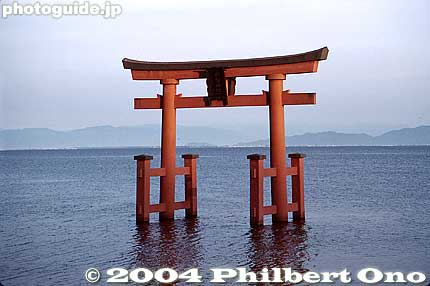
| 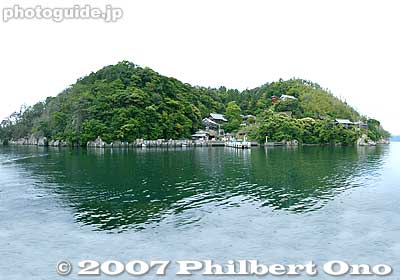
| 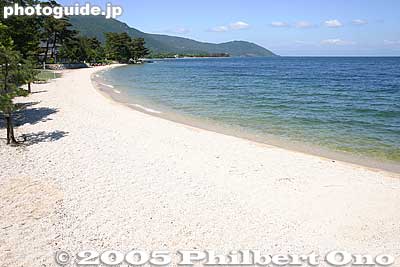
|
| Ukimido Temple | Shirahige Shrine | Chikubushima | Omi-Maiko |

| 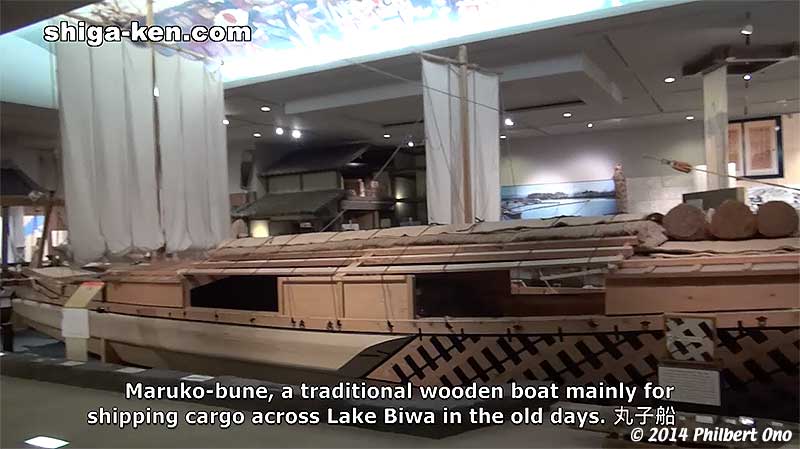
| 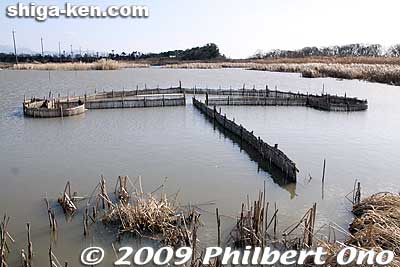
| 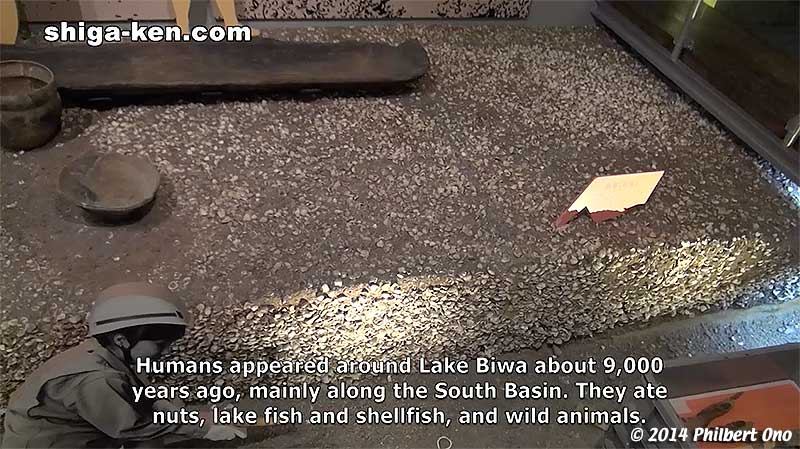
|
| Maruki-bune | Maruko-bune | Eri fish trap | Awazu Shell Mound |
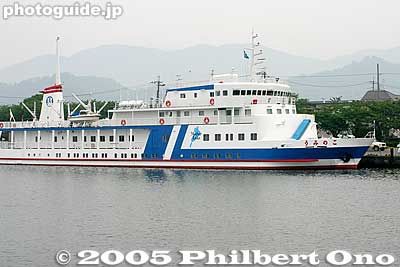
| 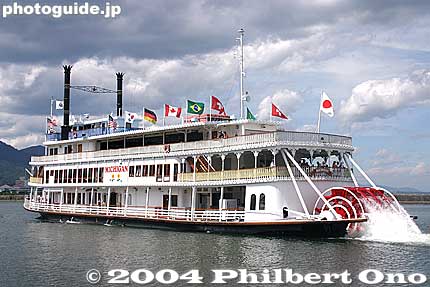
| 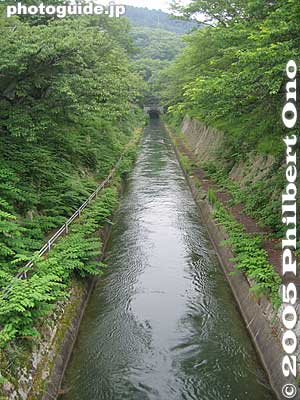
| 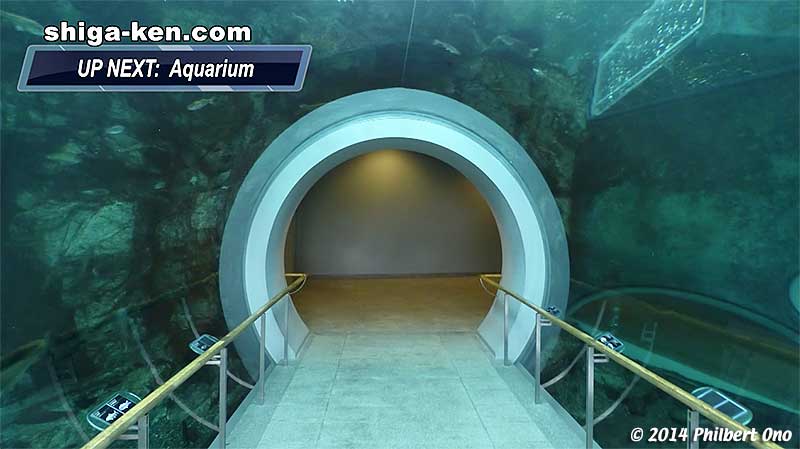
|
| Floating School | Michigan | Lake Biwa Canal | Lake Biwa Museum |
More photos of Lake Biwa:
- Lake Biwa Views
- Chikubushima island
- Mt. Shizugatake
- Kaizu-Osaki cherry blossoms
- Oku-Biwako Parkway
- Ukimido Floating Temple
- Shirahige Shrine
- Omi-Maiko beach
- Shiga Woodblock Prints by Hiroshige
- Lake Biwa Canal
- Lake Biwa Museum
- Maruko-bune Museum
- Kohoku Waterfowl Park
- Okishima island
- Takeshima island, Hikone
- Hayasaki Naiko Biotope (Attached lake)
- Uminoko Floating School
- Rowing around Lake Biwa
- Seta Rowing Club
- Little Grebe Regatta
- Lake Biwa Rowing Song Monuments
- Michigan paddlewheel boat cruise
Videos
Related Articles
- Shiga Prefecture Sights
- History of Shiga Prefecture
- National_Treasures_of_Shiga_Prefecture
- Shiga Prefecture Transportation
- Category:Transportation in Shiga - Index to transportation-related articles.
- Lake Biwa Rowing Song - English version of Shiga Prefecture's most famous song sung in English. Audio and video downloads available!
- Biwako Shuko no Uta(日本語)- Shiga Prefecture's most famous song explained in Japanese.
External Links
- shiga-ken.com - Comprehensive guide to Shiga Prefecture in English.
| Municipalities of Shiga Prefecture 滋賀県 | ||
| Cities & Towns: Aisho-cho | Higashi-Omi | Hikone | Hino-cho | Koka | Konan | Kora-cho | Kusatsu | Maibara | Moriyama | Nagahama | Omi-Hachiman | Otsu | Ritto | Ryuo-cho | Taga-cho | Takashima | Toyosato-cho | Yasu | ||
| 愛荘町 | 東近江市 | 彦根市 | 日野町 | 甲賀市 | 湖南市 | 甲良町 | 草津市 | 米原市 | 守山市 | 長浜市 | 近江八幡市 | 大津市 | 栗東市 | 竜王町 | 多賀町 | 高島市 | 豊郷町 | 野洲市 | ||
